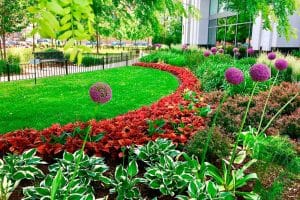 Landscaping is a strategic investment that can elevate the visual appeal, functionality, and overall value of any commercial property. Whether you manage an office complex, a retail center, or an industrial park, the landscape design and maintenance play a crucial role in shaping the first impression and ongoing experience for your customers, partners, and employees. In this comprehensive guide, we’ll explore the key principles and best practices of commercial landscaping, empowering you to transform your outdoor spaces into vibrant, functional, and sustainable showcases that drive business success.
Landscaping is a strategic investment that can elevate the visual appeal, functionality, and overall value of any commercial property. Whether you manage an office complex, a retail center, or an industrial park, the landscape design and maintenance play a crucial role in shaping the first impression and ongoing experience for your customers, partners, and employees. In this comprehensive guide, we’ll explore the key principles and best practices of commercial landscaping, empowering you to transform your outdoor spaces into vibrant, functional, and sustainable showcases that drive business success.
Understanding the Importance of Commercial Landscaping
Commercial landscaping is more than just mowing the lawn and trimming the hedges; it’s a multifaceted discipline that combines horticulture, design, and strategic planning. A well-designed and meticulously maintained landscape can have a profound impact on your business, offering a range of benefits that go beyond mere aesthetics.
Enhancing Curb Appeal and First Impressions
The landscape is often the first thing visitors and potential customers notice about your commercial property. A visually appealing, well-maintained outdoor space can create a lasting positive impression, setting the tone for their entire experience and reflecting the professionalism and attention to detail of your organization.
Boosting Property Value and Attracting Tenants
Investing in commercial landscaping can significantly increase the value of your property, making it more desirable for potential tenants and enhancing its overall market appeal. A well-designed landscape not only adds to the aesthetic appeal but also demonstrates the property’s commitment to sustainability and environmental responsibility.
Improving Employee Productivity and Morale
Research has shown that exposure to natural elements, such as plants and greenery, can have a positive impact on employee well-being, reducing stress and increasing productivity. By incorporating thoughtful landscaping features, you can create inviting outdoor spaces for your team to recharge, collaborate, and find inspiration.
Promoting Sustainability and Environmental Stewardship
As environmental consciousness continues to grow, commercial property owners and managers are increasingly seeking sustainable landscaping solutions that minimize resource consumption and reduce their carbon footprint. Incorporating eco-friendly practices, such as water-wise irrigation and the use of native plant species, can align your property with the values of environmentally conscious customers and partners.
Mastering the Art of Commercial Landscape Design
Successful commercial landscaping is as much an art as it is a science. Crafting a visually stunning and functionally efficient outdoor space requires a deep understanding of horticulture, design principles, and the unique needs of your commercial property.
Defining the Landscape’s Purpose and Objectives
Before embarking on a commercial landscaping project, it’s essential to clearly define the overarching goals and objectives for the outdoor space. This could include enhancing curb appeal, improving traffic flow, creating inviting gathering areas, or showcasing your organization’s commitment to sustainability. By aligning the landscape design with these specific purposes, you can ensure that every element works in harmony to achieve the desired outcomes.
Incorporating Strategic Layout and Design
The layout and design of the commercial landscape play a crucial role in its functionality and overall appeal. Thoughtful consideration should be given to elements such as walkways, parking areas, seating arrangements, and the placement of focal points like water features or sculptural elements. By optimizing the flow of foot traffic and creating visually striking focal points, you can guide visitors through the space and leave a lasting impression.
Selecting the Right Plant Palette
The choice of plant species is a critical component of commercial landscape design. Factors such as climate, soil conditions, and maintenance requirements should be carefully evaluated to ensure the long-term health and vibrancy of the landscape. Incorporating a diverse mix of native and adapted plant varieties can not only enhance the visual appeal but also promote biodiversity and reduce the need for excessive maintenance.
Integrating Hardscaping and Softscaping Elements
The combination of hardscaping (such as pathways, walls, and seating areas) and softscaping (including plants, trees, and lawn) is essential for creating a cohesive and visually appealing commercial landscape. By strategically blending these elements, you can define distinct zones, enhance functionality, and achieve a harmonious balance between the natural and built environments.
Addressing Seasonal Considerations
Successful commercial landscaping requires an understanding of how the landscape will evolve throughout the year. Incorporating a diverse palette of plants that offer year-round interest, from vibrant spring blooms to the fiery foliage of autumn, can ensure that your outdoor spaces remain visually captivating regardless of the season.
Mastering Commercial Landscape Maintenance
Maintaining the long-term health, functionality, and aesthetic appeal of a commercial landscape is a continuous process that requires a comprehensive approach. Effective maintenance not only preserves the initial investment but also ensures that the outdoor space continues to serve as a valuable asset for your business.
Developing a Tailored Maintenance Plan
Every commercial property is unique, with its own set of environmental conditions, usage patterns, and maintenance requirements. Crafting a customized maintenance plan that addresses these specific needs is crucial for ensuring the ongoing success of the landscape. This may include regular mowing, pruning, fertilization, pest management, and irrigation system maintenance, among other tasks.
Ensuring Proper Watering and Irrigation
Proper irrigation is a critical aspect of commercial landscape maintenance, as both under-watering and over-watering can have detrimental effects on plant health and overall appearance. Implementing efficient irrigation systems, monitoring soil moisture levels, and adjusting watering schedules based on seasonal and climatic changes can help maintain the optimal hydration levels for a thriving landscape.
Adhering to Sustainable Practices
As environmental consciousness continues to grow, commercial property owners and managers are increasingly seeking sustainable landscaping solutions that minimize resource consumption and reduce their carbon footprint. This may involve the use of drought-tolerant plant species, water-efficient irrigation systems, and the responsible application of fertilizers and pesticides.
Prioritizing Safety and Risk Mitigation
Maintaining a safe and hazard-free commercial landscape is not only a legal requirement but also a critical aspect of protecting the well-being of your employees, customers, and visitors. Regular inspections, prompt repairs, and the implementation of safety measures, such as uneven surface corrections and proper drainage, can help mitigate potential risks and ensure a secure outdoor environment.
Fostering Long-Term Partnerships with Landscaping Professionals
Establishing a collaborative partnership with a reputable commercial landscaping company can be invaluable in ensuring the ongoing success of your outdoor spaces. These professionals bring a wealth of expertise, industry knowledge, and access to the latest techniques and equipment, enabling you to maintain a thriving and visually stunning landscape without the burden of managing it entirely in-house.
Navigating the Complexities of Commercial Landscaping
While the benefits of a well-designed and meticulously maintained commercial landscape are numerous, the process of achieving these results is not without its challenges. By being aware of these complexities and proactively addressing them, you can ensure the long-term success of your outdoor spaces.
Addressing Unique Site Conditions and Constraints
Every commercial property presents its own set of unique site conditions, such as soil types, microclimates, and existing infrastructure, which can significantly impact the landscape design and maintenance requirements. Conducting a thorough site analysis and consulting with landscape professionals can help you navigate these complexities and develop tailored solutions.
Ensuring Regulatory Compliance and Permitting
Depending on your location and the scope of your commercial landscaping project, you may be subject to various local, state, or federal regulations and permitting requirements. Familiarizing yourself with these guidelines and working closely with relevant authorities can help you avoid costly delays and ensure compliance throughout the project lifecycle.
Managing Budgets and Cost Considerations
Investing in commercial landscaping is a long-term commitment that requires careful budgeting and cost management. From the initial design and installation to ongoing maintenance, understanding the various cost factors and allocating resources accordingly can help you maximize the return on your investment and maintain the landscape’s visual appeal and functionality over time.
Addressing Seasonal Challenges and Variations
Commercial landscapes must withstand the changing seasons and weather patterns, which can present unique challenges and maintenance requirements. Developing a comprehensive seasonal maintenance plan, adjusting irrigation schedules, and proactively addressing potential issues can help you maintain a thriving outdoor space year-round.
Fostering Effective Communication and Collaboration
Successful commercial landscaping often involves the coordination of multiple stakeholders, including property owners, facility managers, landscape designers, and maintenance crews. Establishing clear communication channels, aligning on project goals, and fostering a collaborative working environment can help ensure the seamless execution and long-term success of your landscape initiatives.
Embracing the Future of Commercial Landscaping
As the commercial real estate landscape continues to evolve, the role of landscaping in enhancing property value, sustainability, and overall user experience is becoming increasingly crucial. By staying informed about emerging trends and embracing innovative solutions, commercial property owners and managers can position their outdoor spaces for long-term success.
Incorporating Sustainable and Eco-Friendly Practices
The growing emphasis on environmental sustainability has driven a shift towards more eco-conscious commercial landscaping practices. This may include the use of drought-tolerant and native plant species, the implementation of water-efficient irrigation systems, and the adoption of sustainable maintenance techniques that minimize the use of chemicals and reduce waste.
Leveraging Technology and Data-Driven Insights
The integration of technology and data analytics is transforming the commercial landscaping industry, enabling property owners and managers to make more informed decisions and optimize the performance of their outdoor spaces. From smart irrigation systems that adapt to real-time weather conditions to data-driven landscape management platforms, these advancements can help enhance efficiency, reduce resource consumption, and improve overall landscape health.
Adapting to Changing User Preferences and Needs
As the way people work, shop, and interact with commercial spaces evolves, the demands and expectations placed on outdoor environments are also shifting. Commercial property owners and managers must be attuned to these changing user preferences and adapt their landscaping strategies accordingly, whether it’s creating more inviting gathering spaces, incorporating recreational amenities, or fostering a stronger connection between the indoor and outdoor environments.
Embracing Innovative Design and Technological Solutions
The commercial landscaping industry is constantly evolving, with new design approaches, materials, and technologies emerging to enhance the functionality, sustainability, and visual appeal of outdoor spaces. By staying informed about these advancements and collaborating with forward-thinking landscape professionals, commercial property owners and managers can position their properties at the forefront of the industry, offering unique and engaging experiences that set them apart from the competition.
We Provide Commercial Landscaping Services
Commercial landscaping services cater to the unique needs of businesses, municipalities, and institutions, aiming to create attractive, functional, and sustainable outdoor environments.
> Learn More
Commercial landscaping is a multifaceted discipline that goes far beyond mere aesthetics. It is a strategic investment that can transform the way your commercial property is perceived, experienced, and valued by your customers, partners, and employees. By understanding the principles of effective landscape design, mastering the art of maintenance, and embracing the latest industry trends and innovations, you can elevate your outdoor spaces and unlock a world of benefits for your business.
Contact us (859-609-9278) for a free consultation!
—
Abou t LandCo Group
t LandCo Group
LandCo Group provides residential and commercial Landscaping services in the Greater Cincinnati / Northern Kentucky area. Our services include landscape design, lighting design, retaining walls, paver patios, concrete work, & more.
> Learn More
